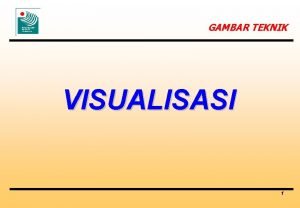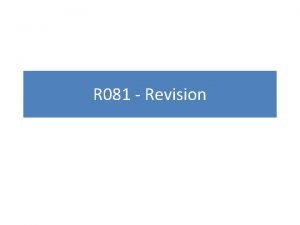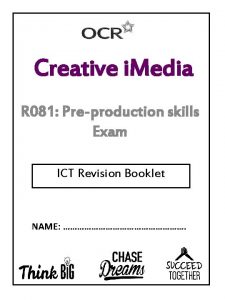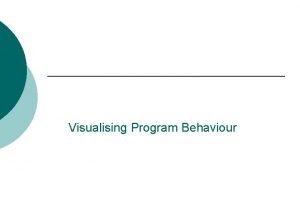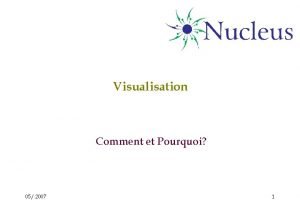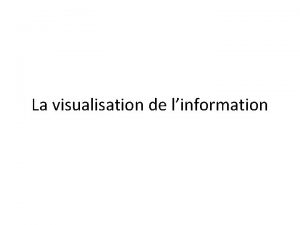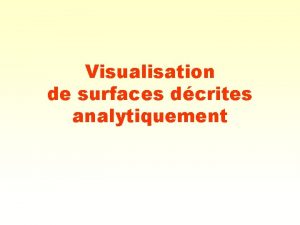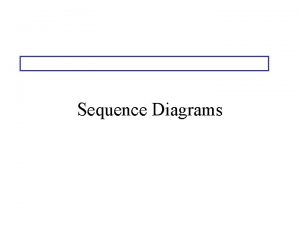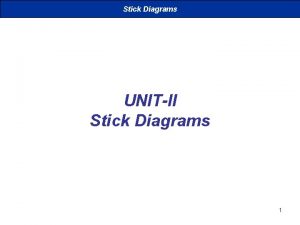VISUALISATION DIAGRAMS THE PURPOSE OF VISUALISATION DIAGRAMS WHAT











- Slides: 11

VISUALISATION DIAGRAMS THE PURPOSE OF VISUALISATION DIAGRAMS

WHAT IS A VISUALISATION DIAGRAM? Simply put, a visualisation diagram is a rough sketch of what you want your end product to look like They can either be hand drawn or created on a computer Being able to draw isn’t important when creating a visualisation diagram, the idea is simply to show your ideas, such as the layout and content of your product A visualisation diagram can be used for any static product. Static means that it doesn’t move, such as an poster or flyer. It wouldn’t be any good for a video as these have lots of different scenes

WHY DO WE USE VISUALISATION DIAGRAMS? 1. Visualisation diagrams are used to plan the layout and design of static products like posters, banners and flyers 2. They are used to show you intend your finished product to look The example on the right is from an exam this student got full marks for this answer

WHAT KIND OF PRODUCTS COULD I USE THESE FOR? Posters Flyers CD/DVD/Blu-ray/Games cover Book/Magazine/Comic book cover � A scene or menu from a game � Webpage � Mobile app layout � � � � Videos/movies/TV adverts Audio/radio advert Animations Games cut scene/video scene Discuss - why is it not suitable for the products listed above?

WHAT SHOULD IT INCLUDE? It is a rough sketch that includes: ● ● ● Images/graphics (including logos) Colours and colour schemes - you will not colour in your design, you will label your colours instead Fonts, sizes and positions of text Annotations to explain the design Navigation (layout and style of buttons, menus etc. ) A good visualisation diagram should be able to show the client what you’re planning to make. There needs to be enough information for them to make a decision as to whether to go with your ideas

WHAT IF THE END PRODUCT DOESN’T LOOK THE SAME? A visualisation diagram is a type of plan - it shows what you intend to do. Your ideas will naturally develop over time and it is usual for you to make changes during the creation of your product e. g. you might decide the original font idea isn’t legible so needs changing

ACTIVITY 6. 1 Have a go at the warm up questions on activity 6. 1 You have 5 minutes to answer these questions

WHAT DOES A GOOD ONE LOOK LIKE? The example on the right was awarded full marks Discuss with the person sat next to you why you think this was

WHAT DOES A GOOD ONE LOOK LIKE? The layout is fully suitable for the front cover of a comic book All the content (images, text, tag line, title, barcode etc. ) is fully suitable and you’d expect to see this on a cover They have clearly shown colours and justified their choice of colour (you don't have to actually colour it in, you’re better saving time and annotating it instead) The annotations are clear, detailed and fully explain (justify) their choices They have clearly thought about the purpose of the product and their target audience and this is also seen in their justifications

ACTIVITY 6. 2 Considering what we’ve just discussed, mark the student answer in activity 6. 2 You have been provided with the mark criteria to help Discuss the answer with your partner and decide on a mark

ACTIVITY 6. 3 It’s time to have a go yourself and complete activity 6. 2 You have been provided with the mark criteria to help Remember to read the question carefully. What are you being asked to design, who is it for, what will it need to include?
 Apa itu visualisasi gambar
Apa itu visualisasi gambar Visualisation
Visualisation Sunflower cataract
Sunflower cataract What would a visualisation diagram be used for
What would a visualisation diagram be used for Pre production visualisation diagram
Pre production visualisation diagram Visualisation
Visualisation Total station visualisation
Total station visualisation Qperm
Qperm An activity diagram is a static model.
An activity diagram is a static model. The interaction diagrams, use case diagrams are called as
The interaction diagrams, use case diagrams are called as Thẻ vin
Thẻ vin Thể thơ truyền thống
Thể thơ truyền thống
